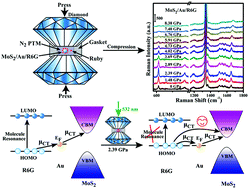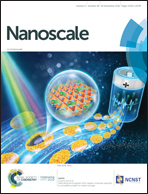Pressure-induced SERS enhancement in a MoS2/Au/R6G system by a two-step charge transfer process†
Abstract
Pressure-induced surface-enhanced Raman spectroscopy (PI-SERS) represents a new frontier in the research field of SERS. However, relatively few studies have focused on PI-SERS due to many difficulties, such as easy aggregation of nanoparticles, and difficulty in understanding the interaction mechanisms between probe molecules and the SERS substrate at high pressure. Here we developed an efficient semiconductor–metal SERS substrate (MoS2/Au) to study PI-SERS. Different from the previously reported monotonous decrease in Raman intensities upon compression, an anomalous Raman enhancement of R6G molecules adsorbed on the MoS2/Au substrate was observed up to 2.39 GPa, at which the degree of charge transfer (ρCT) between the R6G molecules and the MoS2/Au substrate reaches a maximum. By comparison, it is proposed that the decoration of Au on the SERS system could bring about a two-step charge transfer (CT) process, introduce localized surface plasmon resonance (LSPR), and thus favor the PI-SERS enhancement. Moreover, this charge transfer also causes obvious changes in the optical behaviors of R6G molecules upon compression. This brings new insights into the SERS study and also offers new ideas for the development of SERS application in high pressure studies.



 Please wait while we load your content...
Please wait while we load your content...